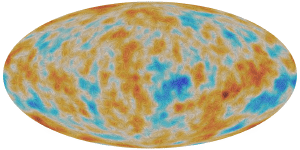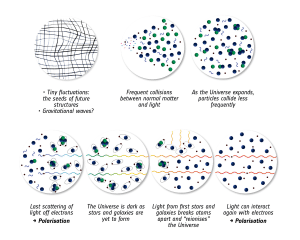Blog
Second Light
7 February 2015
 ESA Planck Mission
ESA Planck MissionIn the standard ΛCDM model of cosmology, the early universe was in a hot dense state known as the big bang. As the universe expanded, its density and temperature dropped to the point where electrons and nuclei could combine to form neutral hydrogen and helium (with small traces of other elements). At that point the light of the universe was finally free to travel great distances through space without colliding with ionized particles. We see that first light as the cosmic microwave background.
After that period (known as recombination) there was no way for new light to be created. The primeval fireball had become too cool to produce new light, and there were no stars to shine. As a result, the universe entered a period known as the dark ages, that spans the time between recombination and the formation of the first stars. Just how long that dark age lasted has been difficult to pin down.
 ESA
ESABased on observations such as the Hubble Deep Field, it’s been estimated that the dark ages ended about 400 million years after the big bang. But new observations from the Planck satellite gives us a much more accurate age of 550 million years after the big bang. This is possible by looking at the polarization of light from the cosmic microwave background. In the last moments before recombination, when the electrons finally started to bond with nuclei, the photons created in the big bang would have one last scatter off an electron before making its long journey across the universe. Because of this the light is polarized, which is one of the things Planck has studied in detail. Throughout the dark ages, that polarization was “fixed” since there was no free electrons for the light to scatter off. But once stars began to form, the new light and heat could re-ionized surrounding material. As a result, some of the light from the cosmic background was scattered again, polarizing it in a different way. This new scattering leaves its fingerprints on the CMB, which tells us when it occurs.
What’s interesting about this new result is that by the time the dark ages ended, stars and galaxies were already forming. This means that by the time stars began to shine the structure of galaxies was already set into motion. The dark ages lasted longer than we though, but it also ended more abruptly than we suspected.